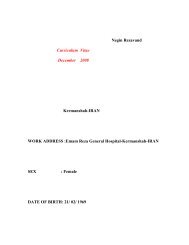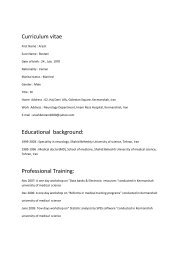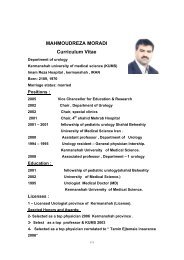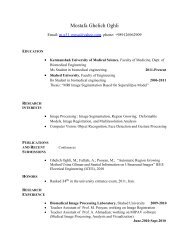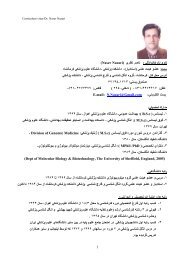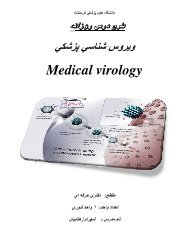- Page 2 and 3:
Methods in Microbiology Volume 27
- Page 4 and 5:
Methods in M i cro bi ol ogy Volume
- Page 6 and 7:
Contents Contributors .............
- Page 8 and 9:
6.10 Bacterial Exotoxins ..........
- Page 10 and 11:
Contributors Carlos F. Ambbile-Cuev
- Page 12 and 13:
Michele Farris Department of Bioche
- Page 14 and 15:
Mark Pallen Microbial Pathogenicity
- Page 16 and 17:
Preface 'I1 n'existe pas de science
- Page 18 and 19:
unknown (or unpredictable) function
- Page 20 and 21:
eflects a growing realization in re
- Page 22 and 23:
SECTION I Detection of Virulence Ge
- Page 24 and 25:
1.1 Detection of Virulence Genes Ex
- Page 26 and 27:
permitting the simultaneous screeni
- Page 28 and 29:
tion have been used successfully to
- Page 30 and 31:
are impaired in their ability to su
- Page 32 and 33:
References most numerous facultativ
- Page 34 and 35:
SECTION 2 Laboratory Safety - Worki
- Page 36 and 37:
2.1 Introduction Paul V. Tearle Nat
- Page 38 and 39:
Reference Thus, in both Chapters 2.
- Page 40 and 41:
2.2 Safe Working Practices in the L
- Page 42 and 43:
it is the physical, noninfectious i
- Page 44 and 45:
difficulty of doing anything about
- Page 46 and 47:
elimination (1, the most effective)
- Page 48 and 49:
Sub-cause Age of staff Poor supervi
- Page 50 and 51:
2.3 Safe Working Practices in the L
- Page 52 and 53:
analysis and audit may also be used
- Page 54 and 55:
W w Second stage controls. . contro
- Page 56 and 57:
By-products Information References
- Page 58 and 59:
SECTION 3 Detection, Speciation and
- Page 60 and 61:
3.1 Introduction Peter Vandamme Pos
- Page 62 and 63:
3.2 Detection Margareta leven Assoc
- Page 64 and 65:
visualization of bacteria, but also
- Page 66 and 67:
days to weeks; many definitive test
- Page 68 and 69:
(NASBA) and the transcription media
- Page 70 and 71:
legionellae in respiratory specimen
- Page 72 and 73:
3.3 Speciation Peter Vandamme Postd
- Page 74 and 75:
classdymg bacteria was analyzed. Am
- Page 76 and 77:
sequences indeed never show signifi
- Page 78 and 79:
3.4 Identification Peter Vandamme P
- Page 80 and 81:
tional growth and metabolization of
- Page 82 and 83:
DNA sequence. Furthermore, 16s rRNA
- Page 84 and 85:
method suffice for numerous isolate
- Page 86 and 87:
List of Suppliers Polyphasic taxono
- Page 88 and 89:
SECTION 4 Host Interactions - Anima
- Page 90 and 91:
4.1 Introduction T. J. Mitchell Div
- Page 92 and 93:
e examined histologically. Organ cu
- Page 94 and 95:
4.2 Interaction of Bacteria and The
- Page 96 and 97:
The complexity of pathogenic mechan
- Page 98 and 99:
++++++ COMPARISON OF DIFFERENT ORGA
- Page 100 and 101:
microscopy can assess cell damage (
- Page 102 and 103:
cient and deficient isogenic varian
- Page 104 and 105:
4.3 Transgenic and Knockout Animals
- Page 106 and 107:
(Hogan et al., 1994). The DNAmay be
- Page 108 and 109:
Knoc k-i n Animals In some experime
- Page 110 and 111:
etween two copies of the tamoxifen-
- Page 112 and 113:
g I Table 4.4. Examples of the use
- Page 114 and 115:
* Table 4.5. Examples of the use of
- Page 116 and 117:
g m Table 4.5 continued IFN-y IFN-Y
- Page 118 and 119:
Numerous knockout mouse strains tha
- Page 120 and 121:
Gossen, M. and Bujard, H. (1992). T
- Page 122 and 123:
Zinkernagel, R., Seimentz, M. and B
- Page 124 and 125:
4.4 Interactions of Bacteria and Th
- Page 126 and 127:
Route of Infection of cloned animal
- Page 128 and 129:
Measure required length of intestin
- Page 130 and 131:
sampling, and be well tolerated by
- Page 132 and 133:
Guerry, P., Pope, P. M., Burr, D. H
- Page 134 and 135:
4.5 Interaction of Bacteria and The
- Page 136 and 137:
washed before resuspending in mediu
- Page 138 and 139:
the bacterial culture broth with th
- Page 140 and 141:
cells in suspension for several rea
- Page 142 and 143:
that bacterial cytotoxic factors or
- Page 144 and 145:
SECTION 5 Host I n te ract io ns -
- Page 146 and 147:
5.1 Introduction Michael J. Daniels
- Page 148 and 149:
References bacteria often carry sin
- Page 150 and 151:
5.2 Testing Pathogenicity Michael J
- Page 152 and 153:
hosts than leaf spotting or wilt pa
- Page 154 and 155:
different plants can be infiltrated
- Page 156 and 157:
Table 5. I. The behavior of X. c pv
- Page 158 and 159:
Rudolph, K., Roy, M. A., Sasser, M.
- Page 160 and 161:
5.3 hup Genes and Their Function Al
- Page 162 and 163:
mental treatments. The timing and a
- Page 164 and 165:
essential positive regulators, or t
- Page 166 and 167: of the Hrp system is presently obsc
- Page 168 and 169: Dong, X., Mindrinos, M., Davis, K.
- Page 170 and 171: 5.4 Avirulence Genes Ulla Bonas lns
- Page 172 and 173: of tissue due to disease developmen
- Page 174 and 175: genes are tested for their plant in
- Page 176 and 177: Bacteria expressing avirulence gene
- Page 178 and 179: 5.5 Extracellular Enzymes Their Rol
- Page 180 and 181: - m Table 5.5. Extracellular enzyme
- Page 182 and 183: +++a++ GENETIC DETERMINANTS OF EXTR
- Page 184 and 185: Consequently, the precise link betw
- Page 186 and 187: processing and so GspG, -H, -I, and
- Page 188 and 189: ++++++ ACKNOWLEDGEMENTS References
- Page 190 and 191: 5.6 Bacterial Phytotoxins Carol L.
- Page 192 and 193: ment. Since most bacterial phytotox
- Page 194 and 195: ecently used in transgenic plants a
- Page 196 and 197: Jones, J. D. G. and Gutterson, N. (
- Page 198 and 199: 5.7 Epiphytic Growth and Survival S
- Page 200 and 201: ++++++ EFFECTS OF SCALE ON SAMPLING
- Page 202 and 203: References should be avoided so tha
- Page 204 and 205: SECTION 6 Biochemical Approaches 6.
- Page 206 and 207: 6.1 Introduction: Fractionation of
- Page 208 and 209: Gram-negative Bacteria Washed bacte
- Page 210 and 211: References trated lipoproteins, whi
- Page 212 and 213: 6.2 The Proteorne Approach C. David
- Page 214 and 215: determining how its removal (e.g. b
- Page 218 and 219: MS acid residues in a polypeptide s
- Page 220 and 221: An extension of the mass matching p
- Page 222 and 223: approaches such as the construction
- Page 224 and 225: infected with C. truchomutis, over
- Page 226 and 227: 6.3 Microscopic Approaches to the S
- Page 228 and 229: The antigen of interest can be loca
- Page 230 and 231: Figure 6.5. Whole-cell preparation
- Page 232 and 233: Table 6.3. Pre-embedding immunolabe
- Page 234 and 235: References Bacterial cell-associate
- Page 236 and 237: 6.4 Characterization of Bacterial S
- Page 238 and 239: against a range of concentrations o
- Page 240 and 241: single class of binding site on the
- Page 242 and 243: Gel Filtration Whole cells are remo
- Page 244 and 245: References This chapter has set out
- Page 246 and 247: List of Suppliers Wall, J., Ayoub,
- Page 248 and 249: 6.5 Characterizing Flagella and Mot
- Page 250 and 251: Phase-contrast microscopic observat
- Page 252 and 253: of flagellar insertion as the ghost
- Page 254 and 255: A last word of advice - do always c
- Page 256 and 257: Tethered Cells Uniflagellate bacter
- Page 258 and 259: Aizawa, $I., Dean, G. E., Jones, C.
- Page 260 and 261: 6.6 Fimbriae: Detection, Purificati
- Page 262 and 263: Type 1 fimbriae, found on the major
- Page 264 and 265: Detection of Fimbriae by Adhesive C
- Page 266 and 267:
~~~ Figure 6.16. Immunoelectron mic
- Page 268 and 269:
References The authors wish to than
- Page 270 and 271:
6.7 Isolation and Purification of C
- Page 272 and 273:
exopolysaccharides, EPSs) are relea
- Page 274 and 275:
cise chemistry of the LPS, and for
- Page 276 and 277:
Hitchcock-Brown whole-cell lysates
- Page 278 and 279:
Gotschlich, E. C., Fraser, 8. A., N
- Page 280 and 281:
6.8 Structural Analysis of Cell Sur
- Page 282 and 283:
26 I 3 Figure 6.18.1-D 'H NMR spect
- Page 284 and 285:
Composition Analysis Colorimetric a
- Page 286 and 287:
sugars with optically active alcoho
- Page 288 and 289:
Periodate oxidation Partial hydroly
- Page 290 and 291:
A 0 8H-lb.20 8 ti- IC. 40 Q ti- tc.
- Page 292 and 293:
the 6-deoxysugars, residues b and d
- Page 294 and 295:
References cal and NMR methods. The
- Page 296 and 297:
List of Suppliers The following is
- Page 298 and 299:
6.9 Techniques for Analysis of Pept
- Page 300 and 301:
peptidoglycan isolation from these
- Page 302 and 303:
control and constant evaluation of
- Page 304 and 305:
Labeling Reaction and Sample Requir
- Page 306 and 307:
Billot-Klein, D., Gutmann, L., Sabl
- Page 308 and 309:
6.10 Bacterial Exotoxins Mahtab Moa
- Page 310 and 311:
ourselves to a summary of character
- Page 312 and 313:
(repeats in toxin) exotoxin family,
- Page 314 and 315:
Aeromonas hydrophila aerolysin, Ser
- Page 316 and 317:
1997). P. aeruginosa exotoxin A and
- Page 318 and 319:
Aktories, K. and Mohr, C. (1992). C
- Page 320 and 321:
Menestrina, G. F. (1991). Electroph
- Page 322 and 323:
6.11 A Systematic Approach to the S
- Page 324 and 325:
6 7 B 1 2 3 4 5 C 1 2 3 N-terminal
- Page 326 and 327:
Analysis of Bacterial Cell Supernat
- Page 328 and 329:
tion as the components of the secre
- Page 330 and 331:
to attribute a role in secretion fo
- Page 332 and 333:
uninterpretable. A number of differ
- Page 334 and 335:
than one secretion machinery with v
- Page 336 and 337:
References overexpression of a wild
- Page 338 and 339:
Merck, K. B., de Cock, H., Verheij,
- Page 340 and 341:
6.12 Detection, Purification, and S
- Page 342 and 343:
an exogenous AHL (preferably OHHL)
- Page 344 and 345:
+++we SEPARATION, IDENTIFICATION AN
- Page 346 and 347:
lock the HPLC columns. Attention sh
- Page 348 and 349:
Figure 6.27. EI-MS fragmentation pa
- Page 350 and 351:
Synthesis of N-(3-oxoacyl)-~-homose
- Page 352 and 353:
6.13 Iron Starvation and Siderophor
- Page 354 and 355:
eceptor proteins form part of a hig
- Page 356 and 357:
phosphate-buffered systems can inte
- Page 358 and 359:
advantages both of speed and chemic
- Page 360 and 361:
produced by other bacterial and fun
- Page 362 and 363:
Ecker, D. J., Loomis, L. D., Cass,
- Page 364 and 365:
SECTION 7 Molecular Genetic Approac
- Page 366 and 367:
7.1 Introduction Charles J. Dorman
- Page 368 and 369:
spectrum of difficulty lies Chlamyd
- Page 370 and 371:
7.2 Genetic Approaches to the Study
- Page 372 and 373:
transposon mutagenesis, which combi
- Page 374 and 375:
Once a virulence gene has been iden
- Page 376 and 377:
References Alpuche-Aranda, C. M., S
- Page 378 and 379:
and virulence determinants in Vibri
- Page 380 and 381:
7.3 Signature Tagged MutagenesW * S
- Page 382 and 383:
sequence twice in a pool of 96 diff
- Page 384 and 385:
Table 7.4. Generation of the mutant
- Page 386 and 387:
Table 7.5. Colony blots 1. Grow the
- Page 388 and 389:
we found that approximately 25% of
- Page 390 and 391:
References List of Suppliers primer
- Page 392 and 393:
7.4 Physical Analysis of the Salmon
- Page 394 and 395:
Table 7.8. Isolation of intact geno
- Page 396 and 397:
Cycle 2 Cycles 3 and 4 Frequently,
- Page 398 and 399:
0 2 4 6 8 10kb t 1 1 1 1 1 1 1 1 1
- Page 400 and 401:
1 2 3 4 5 I II Figure 7.3. (a) Auto
- Page 402 and 403:
List of Suppliers Liu, S.-L., Hesse
- Page 404 and 405:
7.5 Molecular Analvsis of Pseudomon
- Page 406 and 407:
of P. aeruginosa virulence genes ha
- Page 408 and 409:
Table 7.13. Murine’ models in use
- Page 410 and 411:
Table 7.14. Virulence of P. oerugin
- Page 412 and 413:
Cash, H. A., Woods, D. E., McCullou
- Page 414 and 415:
Stieritz, D. D. and Holander, I. A.
- Page 416 and 417:
7.6 Molecular Genetics of Bordetell
- Page 418 and 419:
are under the control of a single g
- Page 420 and 421:
which may play a fundamental role i
- Page 422 and 423:
et al., 1988). On the contrary, the
- Page 424 and 425:
Figure 7.6. Schematic representatio
- Page 426 and 427:
Beier, D., Schwarz, B., Fuchs, T. M
- Page 428 and 429:
7.7 Genetic Manipulation of Enteric
- Page 430 and 431:
confers a catalase-positive phenoty
- Page 432 and 433:
esistance (Tc) (Sougakoff et al., 1
- Page 434 and 435:
Figure 7.7. (b) Schematic outline o
- Page 436 and 437:
Natural transformation strains test
- Page 438 and 439:
References There has been rapid pro
- Page 440 and 441:
List of Suppliers of ferritin to ir
- Page 442 and 443:
7.8 Molecular Approaches for the St
- Page 444 and 445:
Table 7.22. Isolation of chromosoma
- Page 446 and 447:
Table 7.25. Protoplast transformati
- Page 448 and 449:
Colonies obtained after transformat
- Page 450 and 451:
References Table 7.29. RNA isolatio
- Page 452 and 453:
List of Suppliers Oxoid Monograph N
- Page 454 and 455:
7.9 Molecular Genetic Analvsis of S
- Page 456 and 457:
Table 7.30. Transposon mutagenesis
- Page 458 and 459:
(2) Linkage between the transposon
- Page 460 and 461:
introduce point mutations generated
- Page 462 and 463:
marker. The majority of bacteria th
- Page 464 and 465:
Resolution of Cointegrants by Trans
- Page 466 and 467:
performed using a fragment encompas
- Page 468 and 469:
transformation frequency is too low
- Page 470 and 471:
quency confines this procedure to c
- Page 472 and 473:
Bramley, A. J., Patel, A. H., O'Rei
- Page 474 and 475:
Novick, R. P. (1990). The staphyloc
- Page 476 and 477:
7.10 Molecular A P proaches to Stud
- Page 478 and 479:
DNA (Tan et al., 1995). Chlamydial
- Page 480 and 481:
was cloned from a pUC 8 expression
- Page 482 and 483:
factors have, so far, been unsucces
- Page 484 and 485:
tion of RNA polymerase core subunit
- Page 486 and 487:
SECTION 8 Gene txpression and Analy
- Page 488 and 489:
8.1 Gene Expression and Analysis Ia
- Page 490 and 491:
in multi-copy can titrate out possi
- Page 492 and 493:
permits direct targeting of putativ
- Page 494 and 495:
Northern blot analysis RT-PCR label
- Page 496 and 497:
accurately and in conjunction with
- Page 498 and 499:
DNA Footprinting This is a widely u
- Page 500 and 501:
(Frackman et al., 1990). It has bee
- Page 502 and 503:
Berg, C. M and Berg, D. E. (1996).
- Page 504 and 505:
List of Suppliers Simpson, D. A. C.
- Page 506 and 507:
SECTION 9 Host Reactions - Animals
- Page 508 and 509:
9.1 Introduction Mark Roberts Depar
- Page 510 and 511:
in the case of septic shock. It is
- Page 512 and 513:
9.2 Strategies for the Studv of Int
- Page 514 and 515:
and saturable inhibition of bacteri
- Page 516 and 517:
adhesins. To facilitate the purific
- Page 518 and 519:
References We thank all the workers
- Page 520 and 521:
9.3 Cytoskeletal Rearrangements Ind
- Page 522 and 523:
(3) The interaction of intimin of e
- Page 524 and 525:
easy. For example, actin rearrangem
- Page 526 and 527:
Using mutated cell lines Inability
- Page 528 and 529:
Rosenshine, I., Donnenberg, M. S.,
- Page 530 and 531:
9.4 Activation and Inactivation of
- Page 532 and 533:
Actin Biochemistry guished. Intrace
- Page 534 and 535:
Figure 9.2. Schematic depiction of
- Page 536 and 537:
++++++ Rho-MODULATING BACTERIALTOXI
- Page 538 and 539:
Since the toxins are catalytically
- Page 540 and 541:
TcdB-I 0463 Tcd B-I 470 TcsL-82 48
- Page 542 and 543:
Effect on Bacterial Use of Actin Li
- Page 544 and 545:
small GTP-binding protein Rho regul
- Page 546 and 547:
tion of phorbol ester-stimulated ph
- Page 548 and 549:
9.5 Strategies for the Use of Gene
- Page 550 and 551:
+++a++ USE OF CYTOKINE AND CYTOKINE
- Page 552 and 553:
T Cell Proliferation Cytokine Studi
- Page 554 and 555:
Antibody Subclasses FACS Analysis S
- Page 556 and 557:
OCallaghan, D., Maskell, D., Liew,
- Page 558 and 559:
SECTION 10 Host Reactions - Plants
- Page 560 and 561:
10.1 Host Reactions - Plants Charle
- Page 562 and 563:
Xanthomonas campestris pv. manihoti
- Page 564 and 565:
immunocytochemical studies within t
- Page 566 and 567:
Figure 10.2. Development of paramur
- Page 568 and 569:
etention and antibody recognition w
- Page 570 and 571:
Figure 10.4. Detection of phenolics
- Page 572 and 573:
Table 10.5. Histochemical detection
- Page 574 and 575:
Figure 10.6. Peroxidase activity in
- Page 576 and 577:
Figure 10.7. Localization of H,02 a
- Page 578 and 579:
A comparative summary of reactions
- Page 580 and 581:
Table 10.9. Preparation of gold pro
- Page 582 and 583:
symptom characteristic of infection
- Page 584 and 585:
Figure 10.10, Detection of flavanoi
- Page 586 and 587:
for conjugation via the hydroxy moi
- Page 588 and 589:
Figure 10.11 (A) Transmitted white
- Page 590 and 591:
References and protein/DNA complexe
- Page 592 and 593:
Buja, M., Eigenbrodt, M. L. and Eig
- Page 594 and 595:
Mansfield, J., Jenner, C., Hockenhu
- Page 596 and 597:
SECTION II Strategies and Problems
- Page 598 and 599:
11.1 Introduction Alejandro Craviot
- Page 600 and 601:
11.2 Strategies for Control of ComG
- Page 602 and 603:
endothelial cells to reach the subm
- Page 604 and 605:
The epidemiology of cholera is an i
- Page 606 and 607:
Table I I. I. Available animal mode
- Page 608 and 609:
acelular combinada con 10s toxoides
- Page 610 and 611:
11.3 Antibiotic Resistance and Pres
- Page 612 and 613:
(1) Enzymatic inactivation of the d
- Page 614 and 615:
ampicillin in these same strains in
- Page 616 and 617:
Single-event antibiotic usage may s
- Page 618 and 619:
SECTION I2 Internet Resources for R
- Page 620 and 621:
12.1 Internet Resources for Researc
- Page 622 and 623:
and DNA sequences (http://www.ncbi.
- Page 624 and 625:
++++++ SEQUENCE DATABASES The US Na
- Page 626 and 627:
searched as one of the options on t
- Page 628 and 629:
Web sites (e.g. httpJ/www.biochern.
- Page 630 and 631:
Index Accidents, 19,31 analysis, 27
- Page 632 and 633:
preliminary considerations, 232-233
- Page 634 and 635:
Exoproteins see Secreted proteins,
- Page 636 and 637:
Immunological detection of fimbriae
- Page 638 and 639:
tissue choice, 78 toxin measurement
- Page 640 and 641:
identification, 20-21 pathogen cate
- Page 642 and 643:
Transgenic animals, 83 in bacterial



